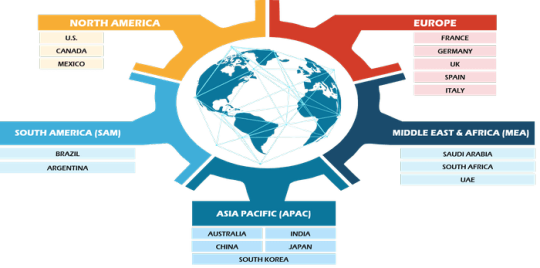#Data Collection Tools Market Trends
Explore tagged Tumblr posts
Text
Data Collection Tools Market Supply, Demand and Analysis by Forecast to 2031

The Insight Partners recently announced the release of the market research titled Data Collection Tools Market Outlook to 2031 | Share, Size, and Growth. The report is a stop solution for companies operating in the Data Collection Tools market. The report involves details on key segments, market players, precise market revenue statistics, and a roadmap that assists companies in advancing their offerings and preparing for the upcoming decade. Listing out the opportunities in the market, this report intends to prepare businesses for the market dynamics in an estimated period.
Is Investing in the Market Research Worth It?
Some businesses are just lucky to manage their performance without opting for market research, but these incidences are rare. Having information on longer sample sizes helps companies to eliminate bias and assumptions. As a result, entrepreneurs can make better decisions from the outset. Data Collection Tools Market report allows business to reduce their risks by offering a closer picture of consumer behavior, competition landscape, leading tactics, and risk management.
A trusted market researcher can guide you to not only avoid pitfalls but also help you devise production, marketing, and distribution tactics. With the right research methodologies, The Insight Partners is helping brands unlock revenue opportunities in the Data Collection Tools market.
If your business falls under any of these categories – Manufacturer, Supplier, Retailer, or Distributor, this syndicated Data Collection Tools market research has all that you need.
What are Key Offerings Under this Data Collection Tools Market Research?
Global Data Collection Tools market summary, current and future Data Collection Tools market size
Market Competition in Terms of Key Market Players, their Revenue, and their Share
Economic Impact on the Industry
Production, Revenue (value), Price Trend
Cost Investigation and Consumer Insights
Industrial Chain, Raw Material Sourcing Strategy, and Downstream Buyers
Production, Revenue (Value) by Geographical Segmentation
Marketing Strategy Comprehension, Distributors and Traders
Global Data Collection Tools Market Forecast
Study on Market Research Factors
Who are the Major Market Players in the Data Collection Tools Market?
Data Collection Tools market is all set to accommodate more companies and is foreseen to intensify market competition in coming years. Companies focus on consistent new launches and regional expansion can be outlined as dominant tactics. Data Collection Tools market giants have widespread reach which has favored them with a wide consumer base and subsequently increased their Data Collection Tools market share.
Report Attributes
Details
Segmental Coverage
Data Type
Data Type Speech Data
Conversational Data
Text-to-Speech Data
Image and Video Data
Others
End-User
Automotive
Government
Healthcare
Financial Services
Retail
IT and Telecom
Others
and Geography
North America
Europe
Asia Pacific
and South and Central America
Regional and Country Coverage
North America (US, Canada, Mexico)
Europe (UK, Germany, France, Russia, Italy, Rest of Europe)
Asia Pacific (China, India, Japan, Australia, Rest of APAC)
South / South & Central America (Brazil, Argentina, Rest of South/South & Central America)
Middle East & Africa (South Africa, Saudi Arabia, UAE, Rest of MEA)
Market Leaders and Key Company Profiles
AI Data Innovations
Appen Limited
CloudApp
Cogito
Global Technology Solutions
Globalme Localization Inc
Google LLC
Keymakr Inc
Labelbox, Inc
Lionbridge Technologies, Inc
Other key companies
What are Perks for Buyers?
The research will guide you in decisions and technology trends to adopt in the projected period.
Take effective Data Collection Tools market growth decisions and stay ahead of competitors
Improve product/services and marketing strategies.
Unlock suitable market entry tactics and ways to sustain in the market
Knowing market players can help you in planning future mergers and acquisitions
Visual representation of data by our team makes it easier to interpret and present the data further to investors, and your other stakeholders.
Do We Offer Customized Insights? Yes, We Do!
The The Insight Partners offer customized insights based on the client’s requirements. The following are some customizations our clients frequently ask for:
The Data Collection Tools market report can be customized based on specific regions/countries as per the intention of the business
The report production was facilitated as per the need and following the expected time frame
Insights and chapters tailored as per your requirements.
Depending on the preferences we may also accommodate changes in the current scope.
Author’s Bio:
Aniruddha Dev
Senior Market Research Expert at The Insight Partners
#Data Collection Tools Market#Data Collection Tools Market Analysis#Data Collection Tools Market Trends#Data Collection Tools Market Scope#Data Collection Tools Market Outlook
0 notes
Text
How to Build a Strong B2B Market Research Plan
Learn how to create a robust B2B market research plan from scratch. Explore strategies, tools, and best practices to drive informed decisions and business growth.
#B2B market research#Market research plan#Business intelligence#Data-driven decision-making#Competitive analysis#Target audience profiling#Industry trends#Market segmentation#Customer needs analysis#SWOT analysis#Market survey#Market assessment#Data collection methods#Market research tools#Market analysis framework#Research strategy#Market research budget#Information sources#Market insights#Market research best practices
0 notes
Text
AD Vantage Loyalty Program Services
AD Vantage is a loyalty program company that helps businesses to retain their customers and drive revenue growth. We provide businesses with the tools and strategies they need to develop and manage effective loyalty programs, which reward customers for their repeat business and incentivize them to be loyal.
Designing and implementing loyalty programs: AD Vantage work with businesses to design and implement loyalty programs that are tailored to their specific needs and goals. We help businesses to determine what rewards and incentives will be most effective in encouraging customer loyalty, and they create the systems and processes needed to manage and track the program.
Data analytics: AD Vantage uses data analytics to track customer behavior and measure the effectiveness of loyalty programs. By analyzing customer data, we identify trends and patterns that help businesses to better understand their customers and develop targeted marketing campaigns.
Customer engagement: Our loyalty programs also play a role in engaging customers and encouraging them to participate in the loyalty program. They create marketing materials and campaigns that promote the benefits of the program, and they provide customer support to help customers understand how to participate.
Technology solutions: The loyalty programs of AD Vantage provide technology solutions that allow businesses to manage their loyalty programs, track customer behavior, and measure program effectiveness. These solutions may include software platforms, mobile apps, and other digital tools that make it easy for businesses to manage and track their loyalty programs.
Customer segmentation: We help businesses segment their customers based on demographics, purchase history, and other factors. This allows businesses to target specific customer groups with personalized rewards and incentives that are more likely to appeal to their interests and needs.
Customer feedback: AD Vantage provide businesses with tools to collect customer feedback, which can be used to improve the loyalty program and other aspects of the customer experience. This feedback can be collected through surveys, reviews, and other methods, and can provide valuable insights into customer preferences and behaviors.
Partnership and alliances: Our loyalty program can help businesses form partnerships and alliances with other companies to offer joint loyalty programs. This can expand the reach of the loyalty program and offer customers more options for rewards and incentives.
customerloyaltyprograms
loyaltyschemes
customerloyaltyprogram
#https://advan.in/loyalty-programs/#AD Vantage is a loyalty program company that helps businesses to retain their customers and drive revenue growth. We provide businesses wit#which reward customers for their repeat business and incentivize them to be loyal.#Designing and implementing loyalty programs: AD Vantage work with businesses to design and implement loyalty programs that are tailored to#and they create the systems and processes needed to manage and track the program.#Data analytics: AD Vantage uses data analytics to track customer behavior and measure the effectiveness of loyalty programs. By analyzing c#we identify trends and patterns that help businesses to better understand their customers and develop targeted marketing campaigns.#Customer engagement: Our loyalty programs also play a role in engaging customers and encouraging them to participate in the loyalty program#and they provide customer support to help customers understand how to participate.#Technology solutions: The loyalty programs of AD Vantage provide technology solutions that allow businesses to manage their loyalty program#track customer behavior#and measure program effectiveness. These solutions may include software platforms#mobile apps#and other digital tools that make it easy for businesses to manage and track their loyalty programs.#Customer segmentation: We help businesses segment their customers based on demographics#purchase history#and other factors. This allows businesses to target specific customer groups with personalized rewards and incentives that are more likely#Customer feedback: AD Vantage provide businesses with tools to collect customer feedback#which can be used to improve the loyalty program and other aspects of the customer experience. This feedback can be collected through surve#reviews#and other methods#and can provide valuable insights into customer preferences and behaviors.#customerloyaltyprograms#loyaltyschemes#customerloyaltyprogram
0 notes
Text
Taller Nepantla: "So where do art and artists stand within this new techno-feudal political landscape?"
1) Artists don’t own anything.
We don’t own the studios. We don’t own the galleries. We don’t own the production of materials. We don’t own the newspapers. We don’t own the art schools and universities. We don’t own the mechanisms of art distribution. We don’t own our work. We don’t even own our own art. Artists have no labor protections and are content to work individually to perpetuate their own myth or pray to the sacred algorithm to go viral. By being atomized we are exactly like a feudal peasant of the Middle Ages, who lives in extreme precariousness giving away part of his crops to his local king. The art world, its industry, its weight, its impact, its trend, everything belongs to other people. Did you know 80% of the art-market is own by a small group of Mega Collectors? Those who control the means of artistic production control the artists.
2) By not owning anything, artists and cultural workers only rent.
We no longer sell handmade works, but instead we sell our hands for work. More and more the creative and artistic sector sells services rather than art. Artists need multiple jobs in order to invest in their art practice. Even more, just as in the feudal stage of history, we work the land in a territory that does not belong to us, the land belongs to the landowner. In this land artists will always pay rent, a tax, to the feudal lord. We use GOOGLE to send emails We upload our art to INSTAGRAM We educate ourselves through YOUTUBE We communicate through TIKTOK We pay to use ADOBE SUIT We buy materials through AMAZON We move through UBER We send files through WETRANSFER Every time we use these platforms, we generate money for the feudal lords.
The art world depends on these platforms, which collect our information and our data, to sell.
When a service is free, our attention is the product. That is, it is impossible for an artist to establish himself as an artist without generating money for the landowners who own the technological platforms. That is, the art world depends on these products. It is impossible to be an artist without using these technologies. Techno-feudalism keeps artists in a situation of -permanent-precariousness dependence on technological platforms. Just like in medieval times, peasants live off the crumbs offered by the crown, living in a house, working on land, and eating food that does not belong to them. Technocapitalists don’t want artists to own the means of artistic reproduction. Technocapitalist instead build a world where everything is rented. Every stage of artistic production from how you imagine an artwork, how you study an artwork, how you draft and artwork, how you build an artwork, how you show an artwork, how you distribute an artwork, how you perceive an artwork, and how you think about an artwork, is all determined by apps and tools which you rented from a tech corporation.
3) Artists SUBSIDIZE the profits of technological platforms.
That is, we pay an inflated price for these services directly from our pockets. The art world depends on the underpaid work of our services. If there were fair wages in the art world, then the entire pyramid wuld be destroyed precisely because it depends on the fact that most artists do not earn a fair wage. All the art we produce and share is being used to train algorithms to better sell us products. When a platform is free, like Facebook, Twitter, Instagram, Tumblr, we are the product that is sold. Even more, artists subsidize the entire artworld. We work for free. We work for low wages. We work for exposure. We are the “volunteer army” Jerry Saltz brags about. The artworld benefits from not paying us what we deserve.
4) The entire art world depends on the platforms of the Clouds.
All museums, galleries, fairs, biennials, and auctions depend on the technological infrastructure dominated by feudal landowners. In other words, there is a dependence on these technologies in order to promise an interconnected, cosmopolitan, and immediate “art world.” The feudal landowners who own the technological platforms, having no competition, can impose whatever price they want, and the art world must obey. They can raise prices without losing customers. The price we pay to use TechnoCapitalist services is completely arbitrary. It does not correspond with the quality of the service but rather to the whims of the landlords. One day, black ink for printing is free, the next day it costs $5.99 a month as a part of a subscription package. We are looking at you Anish Kapoor.
5) The algorithm decides what counts as talent as long as it can generate profits.
Algorithms are increasingly deciding what counts as “value.” Major collectors will be able to systematize the works on the market in order to deduce, through algorithms, the value of a work and whether it is a good investment. The algorithm has more power than art critics and art historians. An artist will then adapt to the algorithmic trends of his time, in order to go viral. A work of art that goes viral can change the artist’s life. NFT’s are just one example of techno-feudal experiments in the arts. NFT’s promise decentralization and transparency, but end up replicating the worst aspects of capitalism, feudalism, and what new technologies can do.
In short, the art world is interconnected with techno-feudalism. We artists are technologically and socially dependent on a system that exploits us. It is important to increase media literacy so that artists can build alternative technological systems to cut dependence on monopolistic companies. A king’s mindset is always to grown and conquer. In the end, the artworld’s investment in techno-feudalism will actively bring the destruction of other smaller artworlds in the global south. Techno-feudalism will produce a homogenized, sanitized, apolitical universal art, that privileges creations that protect the artworlds overlords."
62 notes
·
View notes
Text
AGARTHA Aİ - DEVASA+ (4)

In an era where technology and creativity intertwine, AI design is revolutionizing the way we conceptualize and create across various industries. From the runway to retail, 3D fashion design is pushing boundaries, enabling designers to craft intricate garments with unparalleled precision. Likewise, 3D product design is transforming everything from gadgets to furniture, allowing for rapid prototyping and innovation. As we explore these exciting advancements, platforms like Agartha.ai are leading the charge in harnessing artificial intelligence to streamline the design process and inspire new ideas.
AI design
Artificial intelligence (AI) has revolutionized numerous industries, and the realm of design is no exception. By leveraging the power of machine learning and advanced algorithms, AI is transforming the way designers create, innovate, and deliver their products. AI-driven tools enable designers to harness vast amounts of data, allowing for more informed decision-making and streamlined workflows.
In the context of graphic design, AI can assist artists in generating ideas, creating unique visuals, and even automating repetitive tasks. For instance, programs powered by AI design can analyze trends and consumer preferences, producing designs that resonate with target audiences more effectively than traditional methods. This shift not only enhances creativity but also enables designers to focus on strategic thinking and ideation.
Moreover, AI is facilitating personalized design experiences. With the help of algorithms that analyze user behavior, products can be tailored to meet the specific needs and tastes of individuals. This level of customization fosters deeper connections between brands and consumers, ultimately driving customer satisfaction and loyalty in an increasingly competitive market.
3D fashion design
In recent years, 3D fashion design has revolutionized the way we create and visualize clothing. Using advanced software and tools, designers can create lifelike virtual garments that allow for innovative experimentation without the need for physical fabric. This trend has not only streamlined the design process but has also significantly reduced waste in the fashion industry.
Moreover, 3D fashion design enables designers to showcase their creations in a more interactive manner. By utilizing 3D modeling and rendering technologies, designers can present their collections in virtual environments, making it easier for clients and consumers to appreciate the nuances of each piece. This immersive experience also helps in gathering valuable feedback before producing the final product.
Furthermore, the integration of 3D fashion design with augmented reality (AR) and virtual reality (VR) technologies is bringing a fresh perspective to the industry. Consumers can virtually try on clothes from the comfort of their homes, thereby enhancing the shopping experience. As this field continues to evolve, it promises to bridge the gap between creativity and technology, paving the way for a sustainable and forward-thinking fashion future.
3D product design
3D product design has revolutionized the way we conceptualize and create products. With advanced software tools and technologies, designers can now create highly detailed and realistic prototypes that are not only visually appealing but also functional. This process allows for a quicker iteration of ideas, enabling designers to experiment with various styles and functionalities before arriving at the final design.
One of the significant advantages of 3D product design is the ability to visualize products in a virtual environment. Designers can see how their creations would look in real life, which is essential for understanding aesthetics and usability. Additionally, this technology enables manufacturers to identify potential issues in the design phase, reducing costs associated with prototype development and rework.
Moreover, the rise of 3D printing has further enhanced the significance of 3D product design. Designers can swiftly turn their digital models into tangible products, allowing for rapid prototyping and small-batch manufacturing. This agility not only speeds up the time-to-market for new products but also paves the way for more innovative designs that were previously impossible to execute.
Agartha.ai
Agartha.ai is a revolutionary platform that merges artificial intelligence with innovative design, creating a new avenue for designers and creators alike. With the rapid advancements in technology, Agartha.ai leverages AI to streamline various design processes, enabling users to produce unique and captivating designs with ease.
The platform provides tools that empower both emerging and established designers to explore the possibilities of AI design. By utilizing intelligent algorithms, Agartha.ai can assist in generating design options, ensuring that creativity is not hindered but enhanced. This results in a more efficient workflow and allows designers to focus on the conceptual aspects of their projects.
One of the standout features of Agartha.ai is its ability to adapt to different design disciplines, such as 3D fashion design and 3D product design. By supporting a broad spectrum of design fields, it positions itself as a versatile tool that meets the evolving needs of today's creative professionals. Whether it's crafting intricate fashion pieces or developing innovative product designs, Agartha.ai is at the forefront of the design revolution.
329 notes
·
View notes
Text
How STON.fi and Dune Analytics Are Changing the Game for TON Blockchain Users

If you’ve ever tried navigating the world of cryptocurrency, you’ll know that it can feel like wandering through a huge city without a map. It’s exciting, but also a little confusing. Now, imagine having a powerful tool that helps you see everything clearly. That’s what the partnership between STON.fi and Dune Analytics does for the TON blockchain. Whether you’re a gamer, trader, or just curious about the crypto world, this integration is here to make things easier, more transparent, and more fun.
Why Gaming in Web3 Matters More Than Ever
Let’s talk about gaming for a second. Imagine you’re playing a game where you can earn rewards—let’s say, special items or tokens that are only valuable inside the game. In the past, these rewards were just digital items, locked within the game. You couldn’t do anything with them outside of the game world. It’s like getting a gift card that can only be used at one store.
Now, with Web3 gaming, everything changes. These items are linked to blockchain technology, making them real assets that can be traded, sold, or even used across different games. It’s like owning a gift card that works at every store in the mall.
STON.fi is at the heart of this shift. As a decentralized exchange (DEX), it allows players, developers, and traders to interact seamlessly. If you’re collecting in-game tokens or rare items, STON.fi enables you to trade or use them in real life. It’s not just about playing games; it’s about turning that time into something more valuable. Imagine getting paid for your achievements—not in game points, but real crypto that you can trade or use as you like.
Why Transparency is the Key to Making Smart Decisions
Think about the last time you made a big purchase. Maybe you bought a new phone or a laptop. Did you check the reviews, look up specs, or read up on the brand’s reputation? Probably. That’s because you wanted to make sure your money was well spent. In the world of crypto, making informed decisions is just as important, if not more. You need to know where your tokens are going, how transactions are being made, and whether the platform you’re using is trustworthy.
That’s where Dune Analytics comes in. By integrating with STON.fi, Dune gives you the ability to see exactly how the platform is performing in real-time. From transaction patterns to token movements, all the important data is available for you to explore.
For example, if you’re looking to invest or trade, Dune lets you track trends, see which tokens are being used the most, and get a better sense of how the market is shifting. It’s like having a financial advisor who helps you see the bigger picture.
What Makes STON.fi the Best Option for TON Users
Imagine you’re at a store looking to buy something important. Would you choose a place that only has a small selection, or one that offers a wide range of items, has good prices, and is easy to navigate? For most of us, the choice is obvious.
STON.fi is that better store. It’s the #1 decentralized exchange (DEX) on the TON blockchain because it offers a huge variety of tokens, fast transactions, and a smooth user experience. The platform is designed to integrate with TON wallets, meaning you can trade any TON-based token easily and securely.
It’s not just about buying and selling. STON.fi has a massive impact on the TON ecosystem, with high liquidity, meaning your trades happen quickly and without issues. Whether you're a developer or a trader, STON.fi gives you everything you need in one place.
What Does This Partnership Mean for You
Think about trying to build something without the right tools. You can’t do it alone, and you can’t just rely on guesswork. You need to see how things are working and adjust accordingly. This is exactly why the integration of Dune Analytics with STON.fi is so powerful.
For traders, it’s about making smarter decisions with all the data available to you.
For gamers, it means understanding how in-game tokens are moving, which can give you an edge in the game economy.
For developers, the partnership provides insights into how users are interacting with your project, which helps you build better products.
With this level of transparency, you’re not just guessing. You can see how everything works in real-time and make decisions based on facts, not assumptions.
Explore Dune on Stonfi
What’s Next:The Future of Web3 is Clearer Than Ever
The Dune Analytics and STON.fi partnership is paving the way for a more transparent, accessible, and rewarding Web3 experience. Whether you're gaming, trading, or building the next big project, this integration makes the process simpler and more reliable.
Imagine a world where you can earn rewards from gaming, trade them seamlessly, and know exactly how your investments are performing. That's the future of Web3, and it’s happening now. With the right tools at your fingertips, you can dive deeper into the world of blockchain and make the most out of every opportunity.
So, whether you’re new to crypto or an experienced trader, don’t just watch from the sidelines. Explore the data, engage with the community, and take full advantage of what STON.fi and Dune Analytics have to offer. The future of decentralized finance and gaming is here—and it’s all within your reach.
7 notes
·
View notes
Text
RECENT SEO & MARKETING NEWS FOR ECOMMERCE, AUGUST 2024

Hello, and welcome to my very last Marketing News update here on Tumblr.
After today, these reports will now be found at least twice a week on my Patreon, available to all paid members. See more about this change here on my website blog: https://www.cindylouwho2.com/blog/2024/8/12/a-new-way-to-get-ecommerce-news-and-help-welcome-to-my-patreon-page
Don't worry! I will still be posting some short pieces here on Tumblr (as well as some free pieces on my Patreon, plus longer posts on my website blog). However, the news updates and some other posts will be moving to Patreon permanently.
Please follow me there! https://www.patreon.com/CindyLouWho2
TOP NEWS & ARTICLES
A US court ruled that Google is a monopoly, and has broken antitrust laws. This decision will be appealed, but in the meantime, could affect similar cases against large tech giants.
Did you violate a Facebook policy? Meta is now offering a “training course” in lieu of having the page’s reach limited for Professional Mode users.
Google Ads shown in Canada will have a 2.5% surcharge applied as of October 1, due to new Canadian tax laws.
SEO: GOOGLE & OTHER SEARCH ENGINES
Search Engine Roundtable’s Google report for July is out; we’re still waiting for the next core update.
SOCIAL MEDIA - All Aspects, By Site
Facebook (includes relevant general news from Meta)
Meta’s latest legal development: a $1.4 billion settlement with Texas over facial recognition and privacy.
Instagram
Instagram is highlighting “Views” in its metrics in an attempt to get creators to focus on reach instead of follower numbers.
Pinterest
Pinterest is testing outside ads on the site. The ad auction system would include revenue sharing.
Reddit
Reddit confirmed that anyone who wants to use Reddit posts for AI training and other data collection will need to pay for them, just as Google and OpenAI did.
Second quarter 2024 was great for Reddit, with revenue growth of 54%. Like almost every other platform, they are planning on using AI in their search results, perhaps to summarize content.
Threads
Threads now claims over 200 million active users.
TikTok
TikTok is now adding group chats, which can include up to 32 people.
TikTok is being sued by the US Federal Trade Commission, for allowing children under 13 to sign up and have their data harvested.
Twitter
Twitter seems to be working on the payments option Musk promised last year. Tweets by users in the EU will at least temporarily be pulled from the AI-training for “Grok”, in line with EU law.
CONTENT MARKETING (includes blogging, emails, and strategies)
Email software Mad Mimi is shutting down as of August 30. Owner GoDaddy is hoping to move users to its GoDaddy Digital Marketing setup.
Content ideas for September include National Dog Week.
You can now post on Substack without having an actual newsletter, as the platform tries to become more like a social media site.
As of November, Patreon memberships started in the iOS app will be subject to a 30% surcharge from Apple. Patreon is giving creators the ability to add that charge to the member's bill, or pay it themselves.
ONLINE ADVERTISING (EXCEPT INDIVIDUAL SOCIAL MEDIA AND ECOMMERCE SITES)
Google worked with Meta to break the search engine’s rules on advertising to children through a loophole that showed ads for Instagram to YouTube viewers in the 13-17 year old demographic. Google says they have stopped the campaign, and that “We prohibit ads being personalized to people under-18, period”.
Google’s Performance Max ads now have new tools, including some with AI.
Microsoft’s search and news advertising revenue was up 19% in the second quarter, a very good result for them.
One of the interesting tidbits from the recent Google antitrust decision is that Amazon sells more advertising than either Google or Meta’s slice of retail ads.
BUSINESS & CONSUMER TRENDS, STATS & REPORTS; SOCIOLOGY & PSYCHOLOGY, CUSTOMER SERVICE
More than half of Gen Z claim to have bought items while spending time on social media in the past half year, higher than other generations.
Shopify’s president claimed that Christmas shopping started in July on their millions of sites, with holiday decor and ornament sales doubling, and advent calendar sales going up a whopping 4,463%.
9 notes
·
View notes
Text
Top Digital Marketing Trends to Watch in 2025
Digital marketing has evolved significantly in recent years, making this field even more exciting. In 2025, several key trends will emerge that will not only transform the marketing landscape but also help your content rank higher. Understanding and adopting these trends effectively is essential.
1. The Growing Impact of Artificial Intelligence (AI)
"In 2025, AI-powered marketing will be the biggest trend in the digital world. It will enhance the use of data and provide a superior consumer experience. With AI, companies can understand customer behavior and deliver personalized experiences based on their needs. Visit editpulse.xyz to explore how we can help you leverage AI for your business.

Examples:
Tools like ChatGPT and Jasper make content generation easier.
AI can recommend products based on a customer’s past purchase behavior.
2. Importance of Personalization
"Today's consumers demand personalized experiences. They are drawn to brands that understand their individual needs and preferences.

Key Points:
Email Marketing Personalization: Sending emails based on customer names, past purchase history, and preferences.
Website Personalization: Displaying content tailored to the customer’s preferences after they log in. Visit http://editpulse.xyz/ to learn how we can help personalize your marketing strategy."
3. Rise of Short-Form Video Content
Short-form video content will dominate marketing strategies in 2025. Platforms like TikTok, Instagram Reels, and YouTube Shorts will help brands connect more effectively with their audience.

Examples:
A restaurant promoting its new menu via short videos.
A fashion brand showcasing its new collection on Instagram Reels.
4. Voice Search Optimization
Voice search is becoming a critical component of digital marketing. In 2025, the usage of voice assistants like Alexa, Google Assistant, and Siri will continue to grow. know more click here

Tips:
Make your website voice-search friendly.
Use long-tail keywords that align with voice search queries.
5. Data Privacy and Ethical Marketing

Data privacy will take center stage in 2025. Brands must prioritize transparency and ethical practices in their marketing efforts.
Key Points:
Obtain consent from customers, which will build trust.
Keep data secure and confidential.
6. Growth of Micro-Influencer Marketing
In 2025, micro-influencers (10,000–50,000 followers) will prove to be more effective for brands. They have a dedicated and highly engaged audience.
Examples:
A beauty brand promoting products through micro-influencers.
A fitness brand collaborating with fitness influencers.

7. Expansion of Social Commerce
Social media is no longer just a medium for connection; it has become a platform for shopping. Social commerce will continue to grow in 2025.
Examples:
Customers can use Instagram’s “Shop Now” feature to buy products directly.
Small businesses can sell their products on Facebook Marketplace.

8. Importance of Interactive Content
Interactive content such as quizzes, polls, and live videos will gain popularity in 2025. These formats allow users to engage with brands more effectively.
Examples:
A fitness brand using Instagram polls to gather feedback on new products.
An education platform engaging students through quizzes.

Conclusion
In 2025, leveraging new technologies and strategies in digital marketing will be crucial. To achieve success, adopt these trends and build stronger relationships with your customers. For more information, visit [Your Website Link].
Remember, by prioritizing consumer experiences and embracing innovation, you can take your brand to new heights."
This keeps the flow intact while inserting the link without changing the message. You can replace editpulse.xyz with your actual website URL. http://editpulse.xyz
#seo#digital#digital art#digital illustration#digital drawing#the amazing digital circus#digital marketing#digital media#seo services#india#india seo services#in indias best digital services
3 notes
·
View notes
Text
Whether you're a student, a journalist, or a business professional, knowing how to do high-quality research and writing using trustworthy data and sources, without giving in to the temptation of AI or ChatGPT, is a skill worth developing.
As I detail in my book Writing That Gets Noticed, locating credible databases and sources and accurately vetting information can be the difference between turning a story around quickly or getting stuck with outdated information.
For example, several years ago the editor of Parents.com asked for a hot-take reaction to country singer Carrie Underwood saying that, because she was 35, she had missed her chance at having another baby. Since I had written about getting pregnant in my forties, I knew that as long as I updated my facts and figures, and included supportive and relevant peer-reviewed research, I could pull off this story. And I did.
The story ran later that day, and it led to other assignments. Here are some tips I’ve learned that you should consider mastering before you turn to automated tools like generative AI to handle your writing work for you.
Find Statistics From Primary Sources
Identify experts, peer-reviewed research study authors, and sources who can speak with authority—and ideally, offer easily understood sound bites or statistics on the topic of your work. Great sources include professors at major universities and media spokespeople at associations and organizations.
For example, writer and author William Dameron pinned his recent essay in HuffPost Personal around a statistic from the American Heart Association on how LGBTQ people experience higher rates of heart disease based on discrimination. Although he first found the link in a secondary source (an article in The New York Times), he made sure that he checked the primary source: the original study that the American Heart Association gleaned the statistic from. He verified the information, as should any writer, because anytime a statistic is cited in a secondary source, errors can be introduced.
Dive Into Databases
Jen Malia, author of The Infinity Rainbow Club series of children’s books (whom I recently interviewed on my podcast), recently wrote a piece about dinosaur-bone hunting for Business Insider, which she covers in her book Violet and the Jurassic Land Exhibit.
After a visit to the Carnegie Museum of Natural History in Pittsburgh, Pennsylvania, Malia, whose books are set in Philadelphia, found multiple resources online and on the museum site that gave her the history of the Bone Wars, information on the exhibits she saw, and the scientific names of the dinosaurs she was inspired by. She also used the Library of Congress’ website, which offers digital collections and links to the Library of Congress Newspaper Collection.
Malia is a fan of searching for additional resources and citable documents with Google Scholar. “If I find that a secondary source mentions a newspaper article, I’m going to go to the original newspaper article, instead of just stopping there and quoting,” she says.
Your local public library is a great source of free information, journals, and databases (even ones that generally require a subscription and include embargoed research). For example, your search should include everything from health databases (Sage Journals, Scopus, PubMed) to databases for academic sources and journalism (American Periodical Series Online, Statista, Academic Search Premier) and databases for news, trends, market research, and polls (the Harris Poll, Pew Research Center, Newsbank, ProPublica).
Even if you find a study or paper that you can’t access in one of those databases, consider reaching out to the study’s lead author or researcher. In many cases, they’re happy to discuss their work and may even share the study with you directly and offer to talk about their research.
Get a Good Filtering System
For journalist Paulette Perhach’s article on ADHD in The New York Times, she used Epic Research to see “dual team studies.” That's when two independent teams address the same topic or question, and ideally come to the same conclusions. She recommends locating research and experts via key associations for your topic. She also likes searching via Google Scholar but advises filtering it for studies and research in recent years to avoid using old data. She suggests keeping your links and research organized. “Always be ready to be peer-reviewed yourself,” Perhach says.
When you are looking for information for a story or project, you might be inclined to start with a regular Google search. But keep in mind that the internet is full of false information, and websites that look trustworthy can sometimes turn out to be businesses or companies with a vested interest in you taking their word as objective fact without additional scrutiny. Regardless of your writing project, unreliable or biased sources are a great way to torpedo your work—and any hope of future work.
For Accuracy, Go to the Government
Author Bobbi Rebell researched her book Launching Financial Grownups using the IRS’ website. “I might say that you can contribute a certain amount to a 401K, but it might be outdated because those numbers are always changing, and it’s important to be accurate,” she says. “AI and ChatGPT can be great for idea generation,” says Rebell, “but you have to be careful. If you are using an article someone was quoted in, you don’t know if they were misquoted or quoted out of context.”
If you use AI and ChatGPT for sourcing, you not only risk introducing errors, you risk introducing plagiarism—there is a reason OpenAI, the company behind ChatGPT, is being sued for downloading information from all those books.
Historically, the Loudest Isn’t the Best
Audrey Clare Farley, who writes historical nonfiction, has used a plethora of sites for historical research, including Women Also Know History, which allows searches by expertise or area of study, and JSTOR, a digital library database that offers a number of free downloads a month. She also uses Chronicling America, a project from the Library of Congress which gathers old newspapers to show how a historical event was reported, and Newspapers.com (which you can access via free trial but requires a subscription after seven days).
When it comes to finding experts, Farley cautions against choosing the loudest voices on social media platforms. “They might not necessarily be the most authoritative. I vet them by checking if they have a history of publication on the topic, and/or educational credentials.”
When vetting an expert, look for these red flags:
You can’t find their work published or cited anywhere.
They were published in an obscure journal.
Their research is funded by a company, not a university, or they are the spokesperson for the company they are doing research for. (This makes them a public relations vehicle and not an appropriate source for journalism.)
And finally, the best endings for virtually any writing, whether it’s an essay, a research paper, an academic report, or a piece of investigative journalism, circle back to the beginning of the piece, and show your reader the transformation or the journey the piece has presented in perspective.
As always, your goal should be strong writing supported by research that makes an impact without cutting corners. Only then can you explore tools that might make the job a little easier, for instance by generating subheads or discovering a concept you might be missing—because then you'll have the experience and skills to see whether it's harming or helping your work.
19 notes
·
View notes
Text
5 Types of Surveys You Should Participate In—And Why It Matters
In today’s fast-paced world, businesses, organizations, and governments rely on accurate data to make decisions. One way they gather this valuable information is through surveys. You might have encountered many types of surveys online or in person, but did you know that your participation can significantly impact change? In this blog, we’ll explore five types of surveys, highlighting why they’re important and why you should consider participating.
1. Customer Satisfaction Surveys
Why They Matter:
Ever wondered why companies ask for your feedback after a purchase? Customer satisfaction surveys are a tool businesses use to gauge how well they meet customer expectations. The insights gained help companies improve their products, services, and overall customer experience.
Why You Should Participate:
Shape the future of products: By providing honest feedback, you influence how companies refine and develop their offerings.
Get better service: Your input helps businesses identify areas where they can improve, which could result in better services for you in the future.
Exclusive rewards: Many companies offer discounts or rewards for completing these surveys, making it a win-win situation for both you and the business.
2. Employee Engagement Surveys
Why They Matter:
Employee engagement surveys are conducted within organizations to understand how employees feel about their workplace. These surveys cover job satisfaction, management, work-life balance, and team dynamics.
Why You Should Participate:
Voice your opinion: If you’re employed, these surveys provide a safe platform to express your thoughts on management, company culture, and work conditions.
Improve your workplace: Honest feedback from employees can drive positive change, improve work environments, and increase job satisfaction for everyone.
Build better leadership: When management understands the concerns and suggestions of their teams, they can create policies and make decisions that support a more motivated and productive workforce.
3. Political Opinion Polls
Why They Matter:
Political opinion polls measure public sentiment about political issues, elections, or government performance. Polls like these inform political leaders, policymakers, and the media about public concerns and opinions.
Why You Should Participate:
Influence decision-making: Your voice adds to a collective view that could influence policy decisions and political discourse.
Shape the political landscape: Politicians and leaders often adjust their priorities based on what the public wants. Your input helps ensure that your concerns are addressed.
Understand trends: Participating in these surveys allows you to see where you stand in comparison to others and gain insight into broader societal trends.
4. Market Research Surveys
Why They Matter:
Market research surveys are used by companies to understand consumer behavior, preferences, and market trends. This research helps businesses decide what products to launch, how to price them, and how to market them.
Why You Should Participate:
Influence new products: Companies rely on feedback from people like you to decide what features to add or what products to create. Your opinion can directly affect future innovations.
Stay ahead of trends: By participating in market research, you often get a sneak peek at new products or services before they hit the market.
Get rewards: Many companies offer incentives such as cash, gift cards, or discounts for participating in market research surveys.
5. Health and Wellness Surveys
Why They Matter:
Health surveys are often conducted by government bodies, research organizations, or healthcare institutions to assess public health trends, study diseases, or improve healthcare services. These surveys play a critical role in shaping health policies and medical research.
Why You Should Participate:
Contribute to scientific research: Participating in health surveys can contribute to advancements in healthcare and medical research, potentially saving lives or improving the quality of care.
Raise awareness: Health surveys help identify trends in public health that may need attention, such as the rise of certain diseases or health conditions.
Improve healthcare services: Your participation allows healthcare providers to understand what patients need, leading to improved services, more targeted treatments, and better patient care.
Why Your Participation Matters:
By participating in surveys, you are helping companies, governments, and organizations make better decisions based on real data. Surveys allow decision-makers to better understand consumer and public needs, ultimately leading to improved products, services, policies, and societal well-being.
Here are three key reasons why you should participate in surveys:
Be heard: Surveys provide a platform where your opinion can directly impact the world around you.
Drive positive change: Whether it's about the workplace, healthcare, or politics, your input can lead to real, actionable change.
Gain benefits: In many cases, surveys come with rewards or incentives, allowing you to get something back in exchange for your time.
So the next time you come across a survey in your inbox or on a website, take a moment to consider participating. Your feedback matters more than you think!
Conclusion: From customer satisfaction surveys to political opinion polls, the surveys we take part in help shape our society. By sharing your thoughts and experiences, you contribute to a better future for everyone. Plus, it’s an easy way to ensure that your voice counts, while sometimes reaping personal rewards along the way!
CLICK HERE TO JOIN and REFER.
#surveys#pink diamond#lapis lazuli#pearl#rose quartz#steven universe#submisive sissy#submisive and breedable#sunset#trump#president trump#trump 2024#fuck trump#donald trump#philippines#wanderlust#virtualtour#traveltips#june1st#travel photography#travel blog#destination#traveling#travel
4 notes
·
View notes
Text

Deep Dives into Tech and Digital Growth Strategies
In an era of rapid technological advancements and evolving business landscapes, understanding the nuances of tech-driven strategies is essential for sustained growth. Companies today must leverage cutting-edge technologies and innovative digital growth strategies to stay competitive. This article takes a deep dive into the world of technology and digital strategies, highlighting how businesses can harness them to achieve their full potential.
Tech Innovation: The Catalyst for Business Evolution
Innovation in technology is reshaping industries, from manufacturing and healthcare to retail and financial services. Businesses that embrace tech innovations can unlock new opportunities and create unique competitive advantages.
Automation and AI: Automation tools and artificial intelligence (AI) are driving efficiency, reducing human errors, and freeing up resources for more strategic tasks. Companies that adopt AI-driven decision-making processes gain valuable insights and predictive analytics.
Cloud Computing: Cloud-based solutions offer businesses scalable, cost-effective options for data storage and software deployment. Cloud technologies facilitate remote work, enhance collaboration, and provide data accessibility from any location.
Internet of Things (IoT): IoT is transforming industries by connecting devices and enabling real-time data collection and analysis. Businesses can leverage IoT to monitor operations, optimize workflows, and improve customer experiences.
5G Connectivity: The rollout of 5G networks is enabling faster communication and data transfer. This enhanced connectivity paves the way for innovations in areas like telemedicine, augmented reality, and autonomous vehicles.
Digital Marketing Strategies for Sustainable Growth
Digital marketing is at the heart of modern business strategies. To stand out in a crowded market, businesses must adopt targeted and innovative marketing tactics.
Search Engine Optimization (SEO): SEO is critical for improving online visibility and driving organic traffic. Businesses should focus on creating high-quality content, optimizing for keywords, and building authoritative backlinks to enhance search engine rankings.
Content Marketing: Content is king when it comes to building brand authority and engaging audiences. Businesses should invest in creating informative, relevant content that addresses customer pain points and provides solutions.
Social Media Engagement: Social media platforms are powerful tools for building brand awareness and fostering community engagement. Consistent posting, audience interaction, and strategic advertising can amplify a brand’s reach.
Data-Driven Marketing: Analyzing marketing performance data allows businesses to make informed decisions and refine strategies. By leveraging analytics tools, businesses can identify trends, understand customer behaviors, and optimize campaigns for better results.
Personalization: Today’s consumers expect personalized experiences. Businesses that use data to tailor their offerings and communication to individual preferences are more likely to build lasting relationships with customers.
Cybersecurity: Protecting Digital Assets
As businesses become more reliant on digital technologies, cybersecurity is paramount. Cyber threats can compromise sensitive data, disrupt operations, and damage reputations. To safeguard digital assets, businesses must implement robust cybersecurity measures.
Multi-Layered Security: Implementing multi-layered security protocols ensures that businesses are protected from various attack vectors. This includes firewalls, intrusion detection systems, and endpoint protection.
Data Encryption: Encrypting sensitive data both in transit and at rest protects it from unauthorized access.
Regular Audits: Conducting regular security audits helps identify vulnerabilities and ensures that security measures are up-to-date.
Employee Training: Human error is a common cause of data breaches. Educating employees on cybersecurity best practices can reduce the risk of phishing attacks and other social engineering tactics.
Customer-Centric Tech Solutions
Understanding and prioritizing customer needs is key to business growth. Tech innovations can enhance customer experiences and build long-term loyalty.
Customer Relationship Management (CRM) Systems: CRM systems help businesses manage customer interactions and provide personalized experiences. By analyzing customer data, businesses can tailor their offerings and improve satisfaction.
Chatbots and Virtual Assistants: AI-powered chatbots offer 24/7 customer support, answering queries and resolving issues in real-time. These tools enhance customer service while reducing operational costs.
Omnichannel Experiences: Today’s consumers interact with businesses across multiple channels. Providing a seamless, consistent experience across all touchpoints—whether online, in-store, or on mobile—is essential for customer satisfaction.
Tech Integration for Operational Efficiency
Integrating technology into core business processes can streamline operations, reduce costs, and improve overall efficiency.
Enterprise Resource Planning (ERP) Systems: ERP systems integrate various business functions into a unified platform, improving visibility and coordination across departments.
Project Management Tools: Digital project management platforms enable teams to collaborate, track progress, and meet deadlines efficiently.
Supply Chain Optimization: Advanced technologies like IoT and blockchain can enhance supply chain transparency, improve inventory management, and reduce delays.
Sustainable Growth with Tech Partnerships
Partnering with tech solution providers can accelerate business transformation and growth. Collaborating with experts allows businesses to access specialized knowledge and cutting-edge technologies without investing heavily in in-house resources.
Scalability: Tech partnerships enable businesses to scale operations as needed, adapting to market demands without significant disruptions.
Innovation: Partnering with tech innovators ensures that businesses stay ahead of industry trends and adopt new technologies as they emerge.
Looking Ahead: Future Trends in Tech and Digital Growth
The tech landscape is constantly evolving, and businesses must stay agile to remain competitive. Emerging trends like artificial intelligence, quantum computing, and edge computing are set to redefine industries. By staying informed and embracing change, businesses can position themselves for long-term success.
Conclusion
Tech4Biz Solutions is committed to empowering businesses with innovative tech solutions and digital growth strategies. Whether it’s leveraging advanced technologies, optimizing marketing efforts, or enhancing customer experiences, Tech4Biz helps businesses unlock new possibilities. By diving deep into the world of tech and digital strategies, companies can fuel growth, drive innovation, and stay ahead of the curve in an ever-changing business landscape. Visit Tech4Biz Solutions to learn more about how we can help transform your business.
5 notes
·
View notes
Text
How the Trust Score on STON.fi Transformed My Crypto Trading

If you’ve been in the crypto world for a while, you probably know how overwhelming it can be. With thousands of tokens in circulation, choosing the right one to invest in can be daunting. Over time, I realized that relying on hype and gut feelings wasn’t the best approach. That’s when I discovered the Trust Score on STON.fi, and it completely changed how I trade. Let me tell you why.
What is the Trust Score
Simply put, the Trust Score is a rating system that helps traders like us make informed decisions about tokens on STON.fi. It looks at several important factors like:
Trading volume: How much activity is happening with a token.
Price fluctuations: How stable or volatile the token is over time.
Liquidity: How easily you can buy or sell a token without affecting its price.
Minting potential: The risk of new tokens being created, which can impact the token's value.
The Trust Score gives each token a percentage rating based on these factors, so you can easily see how healthy or risky a token might be.
Why Does It Matter
When I first started trading crypto, I was easily swayed by the latest trends or what others were talking about online. But soon, I realized that many of those "hot" tokens didn’t have strong fundamentals. They were just popular for a moment.
The Trust Score helped me avoid these quick hype cycles. Instead of just chasing the latest token, I started using the Trust Score to assess whether a token was genuinely worth my time. If a token had a high Trust Score, it meant it was backed by solid data. If it had a low score, it raised a red flag for me.
How the Trust Score System Changed My Strategy
Using the Trust Score has completely shifted how I approach crypto trading. Here’s how:
1. It saves time: Instead of spending hours researching every token I’m interested in, I can quickly check the Trust Score. If the score is good, it tells me the token is worth looking into more.
2. It helps reduce risk: When I see a token with a low Trust Score, I now know that there are probably some underlying issues with it. This helps me avoid risky investments and focus on more stable options.
3. It highlights opportunities: I’ve discovered some of my best trades by looking at tokens with high Trust Scores that weren’t trending. These hidden gems often have strong fundamentals that others might overlook.
Real-Life Example of How Trust Score Helped Me
There was one time when a new token was getting a lot of attention on social media. Everyone seemed to be talking about it, and the FOMO hit me hard. But when I checked the Trust Score, I saw that the liquidity was low, and the price was highly volatile. Instead of rushing in, I decided to pass on it. A few weeks later, the price had dropped significantly. I was glad I trusted the data rather than the hype.
On the other hand, I found another token with a solid Trust Score that wasn’t getting much attention. After doing a little more research, I saw it had great potential. I invested, and the price steadily rose over the following months.
Why Trust Score Works for Everyone
What I love about the Trust Score system is that it’s simple enough for anyone to use. Whether you’re new to crypto or an experienced trader, you can easily look at the Trust Score and get a sense of whether a token is a good investment. For beginners, it’s a straightforward way to get a sense of a token’s stability. For experienced traders like me, it serves as another useful tool to confirm or challenge our decisions.
How Trust Score Helps the Crypto Ecosystem
The more people who use the Trust Score system, the better it is for the entire crypto ecosystem. By relying on data, rather than just hype, we all help create a more transparent, trustworthy market. As more traders use tools like the Trust Score, we can collectively reduce market manipulation and increase the overall stability of the market.
Final Thoughts
Crypto trading is unpredictable, and the risks are high. But by using the Trust Score system on STON.fi, I’ve been able to make smarter, more informed decisions. It’s helped me avoid bad investments, find promising tokens, and most importantly, trade with more confidence.
If you haven’t already, I highly recommend giving the Trust Score a try. It’s not a guarantee of success, but it’s a tool that has certainly made my trading journey easier and less stressful. How do you make your trading decisions? I’d love to hear your thoughts on how you assess tokens and whether the Trust Score system has helped you too.
2 notes
·
View notes
Text
How STON.fi and Dune Analytics Are Making the TON Blockchain Easier to Navigate

Think of blockchain as a massive city. Navigating it without the right tools is like trying to find your way through a crowded, confusing maze. But when you have a map, things get a lot clearer. That’s what happens with the integration of Dune Analytics and STON.fi on the TON blockchain. This partnership is like handing you the perfect guide to explore the world of crypto, from trading to gaming.
Let’s break it down in simple terms so everyone can understand how this is a game-changer—whether you’re just getting started with crypto, already trading, or even gaming in the Web3 space.
Why Web3 Gaming Matters
Imagine you’re playing a game and collecting rewards—let’s say some cool new weapons or rare items. In the old world of gaming, these items exist only in the game. You can’t trade them or use them outside the game. It’s like collecting stamps in a collection book—they’re nice to look at but don’t really do anything.
Now, picture a different world, the Web3 gaming world. Here, the items you earn have real-world value. You can sell them, trade them, or even use them on different platforms. That’s because they’re tied to blockchain technology, which makes these items real, tradable assets.
STON.fi helps make this world possible. As a decentralized exchange (DEX), it lets players, developers, and traders interact seamlessly. If you’re earning in-game tokens or collectibles, you can now trade them, making gaming a lot more rewarding—just like turning your passion into a side income.
The Power of Transparency: Why It Matters
In any investment or transaction, you need to know what’s going on behind the scenes, right? Think of it like checking a company’s financial reports before deciding to invest in their stock. Would you put money into something if you couldn’t see the numbers? Probably not.
That’s what Dune Analytics brings to the table for TON and STON.fi. By integrating with Dune, all the data from STON.fi becomes visible to you. You can track everything from transaction patterns to trends in how tokens are being used across the blockchain.
For instance:
Traders can spot patterns and make smarter moves.
Gamers can see how tokens are being used in real-time, which helps them understand the economy of the games they’re playing.
Developers get insights into how users are interacting with their projects, enabling them to build better products.
This transparency gives you the power to make informed decisions, just like using a map to navigate that maze.
Why STON.fi is the Leading Platform on TON
Imagine trying to buy or sell something, but the platform you’re using has limited options, slow transactions, or doesn’t support the things you want to trade. It’s frustrating, right? STON.fi changes that.
It’s not just another platform—it’s the backbone of the TON blockchain ecosystem. Here’s why:
1. Variety: STON.fi offers a wide range of tokens for you to trade, from in-game assets to more traditional crypto.
2. Liquidity: The platform’s high liquidity ensures your transactions happen quickly and without issues.
3. Ease of Use: With its integration into TON wallets, trading is as simple as clicking a button.
STON.fi is like a bustling market where traders, developers, and gamers meet. Everything you need to buy, sell, or trade is in one place, and it’s optimized for speed and security.
What This Integration Means for You:
Think about trying to build a house. You have the foundation, but without the right tools, it’s hard to put everything together. Dune Analytics is like giving you those tools. It makes everything in the TON blockchain visible and accessible, which is especially useful for:
Users who want to see how tokens are performing, so they can make informed decisions.
Developers who need data to improve their applications and create more engaging experiences.
Gamers who want to know how the game economy works so they can maximize their rewards.
This level of insight was hard to get before, but with Dune and STON.fi working together, everything you need to succeed is right there in front of you.
The Future of Web3: Transparent, Accessible, and For You
The partnership between Dune Analytics and STON.fi is just the beginning. It’s not just about trading tokens or collecting in-game rewards; it’s about creating a world where blockchain technology is easy to navigate, transparent, and accessible to everyone.
Whether you’re a gamer who wants to turn your achievements into real-world value, a trader looking for a reliable platform, or a developer working on the next big thing, this integration makes it easier for you to succeed.
Explore Dune on Stonfi
So, take a moment to explore what’s possible with STON.fi and Dune Analytics. The Web3 world is waiting, and now, with the right tools and insights, you’re more prepared than ever to dive in and make the most of it.
6 notes
·
View notes
Text
Why Should You Do Web Scraping for python

Web scraping is a valuable skill for Python developers, offering numerous benefits and applications. Here’s why you should consider learning and using web scraping with Python:
1. Automate Data Collection
Web scraping allows you to automate the tedious task of manually collecting data from websites. This can save significant time and effort when dealing with large amounts of data.
2. Gain Access to Real-World Data
Most real-world data exists on websites, often in formats that are not readily available for analysis (e.g., displayed in tables or charts). Web scraping helps extract this data for use in projects like:
Data analysis
Machine learning models
Business intelligence
3. Competitive Edge in Business
Businesses often need to gather insights about:
Competitor pricing
Market trends
Customer reviews Web scraping can help automate these tasks, providing timely and actionable insights.
4. Versatility and Scalability
Python’s ecosystem offers a range of tools and libraries that make web scraping highly adaptable:
BeautifulSoup: For simple HTML parsing.
Scrapy: For building scalable scraping solutions.
Selenium: For handling dynamic, JavaScript-rendered content. This versatility allows you to scrape a wide variety of websites, from static pages to complex web applications.
5. Academic and Research Applications
Researchers can use web scraping to gather datasets from online sources, such as:
Social media platforms
News websites
Scientific publications
This facilitates research in areas like sentiment analysis, trend tracking, and bibliometric studies.
6. Enhance Your Python Skills
Learning web scraping deepens your understanding of Python and related concepts:
HTML and web structures
Data cleaning and processing
API integration
Error handling and debugging
These skills are transferable to other domains, such as data engineering and backend development.
7. Open Opportunities in Data Science
Many data science and machine learning projects require datasets that are not readily available in public repositories. Web scraping empowers you to create custom datasets tailored to specific problems.
8. Real-World Problem Solving
Web scraping enables you to solve real-world problems, such as:
Aggregating product prices for an e-commerce platform.
Monitoring stock market data in real-time.
Collecting job postings to analyze industry demand.
9. Low Barrier to Entry
Python's libraries make web scraping relatively easy to learn. Even beginners can quickly build effective scrapers, making it an excellent entry point into programming or data science.
10. Cost-Effective Data Gathering
Instead of purchasing expensive data services, web scraping allows you to gather the exact data you need at little to no cost, apart from the time and computational resources.
11. Creative Use Cases
Web scraping supports creative projects like:
Building a news aggregator.
Monitoring trends on social media.
Creating a chatbot with up-to-date information.
Caution
While web scraping offers many benefits, it’s essential to use it ethically and responsibly:
Respect websites' terms of service and robots.txt.
Avoid overloading servers with excessive requests.
Ensure compliance with data privacy laws like GDPR or CCPA.
If you'd like guidance on getting started or exploring specific use cases, let me know!
2 notes
·
View notes
Text
How Generative AI is Transforming Telemedicine and Remote Healthcare

Generative AI is rapidly reshaping the landscape of telemedicine and remote healthcare, introducing innovative solutions that enhance patient care and operational efficiency. By leveraging advanced algorithms, generative AI can analyze vast amounts of medical data, create personalized treatment plans, and support clinical decision-making.
One of the most notable contributions of generative AI is its ability to bridge gaps in diagnostic services. AI models can generate insights from medical images, such as X-rays or MRIs, helping healthcare professionals detect conditions early and accurately. These tools are particularly beneficial in underserved regions, where access to specialized care is limited.
Generative AI also plays a pivotal role in improving patient engagement. Chatbots and virtual assistants powered by AI provide round-the-clock support, answering queries, scheduling appointments, and offering tailored health recommendations. This not only improves patient experience but also reduces the burden on healthcare providers.
Furthermore, AI-driven tools are being used to simulate treatment outcomes, enabling doctors to refine approaches before implementation. This predictive capability minimizes risks and ensures more effective care delivery.
As generative AI continues to advance, it holds immense potential to transform telemedicine into a more accessible, efficient, and patient-centered domain. However, addressing ethical concerns, such as data privacy and algorithmic bias, remains critical to unlocking its full potential.
Generative AI is not just a technological trend; it is a driving force in the evolution of modern healthcare, bringing quality care closer to those who need it most.
To know more: data collection services
healthcare market research services
3 notes
·
View notes
Text
From Data to Decisions: AI's Role in Competitive Market Analysis

In today’s fast-paced business environment, staying ahead of the competition requires actionable insights derived from reliable data. Traditional market research methods, while effective, often fall short when it comes to speed, scalability, and real-time analysis. This is where AI-driven market research platforms come into play, revolutionizing the way businesses gather and interpret market intelligence.
What Makes AI-Driven Platforms Stand Out?
Speed and Efficiency AI tools process vast amounts of data in real time, enabling companies to respond quickly to market trends and shifts. Unlike manual methods, AI reduces the time spent collecting and analyzing data, ensuring that businesses remain agile.
Enhanced Accuracy By leveraging machine learning algorithms, AI platforms can identify patterns and insights with greater precision. This reduces human error and provides a more accurate picture of customer behaviors, preferences, and market dynamics.
Personalized Insights AI tools can segment audiences and tailor insights to specific business needs. Whether it's understanding niche customer preferences or tracking competitor activities, these platforms adapt to provide relevant and actionable data.
Meeting Competitive Expectations
The competitive landscape demands more than just knowing what customers want; it requires foresight into industry trends and competitor strategies. AI-driven platforms meet these demands by offering:
Predictive Analytics: Anticipating future trends based on historical and real-time data.
Competitor Analysis: Monitoring rivals’ activities to identify opportunities and threats.
Market Segmentation: Breaking down broad markets into actionable segments for targeted strategies.
The Bottom Line
AI-driven market research platforms are not just tools; they are strategic assets. By unlocking deeper market insights, they empower businesses to make data-driven decisions, maintain a competitive edge, and adapt to ever-changing market dynamics. Companies that embrace this technology position themselves to lead, rather than follow, in their industries.
The future of market research is here, powered by AI.
To know more: online market research platforms
panel management platform
Sample Management Platform
#market research#onlineresearch#samplemanagement#panelmanagement#communitypanel#onlinesurvey#datainsights
4 notes
·
View notes